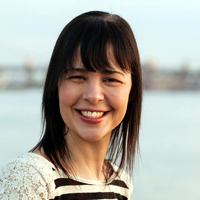Allyson Sheffield, PhD, associate professor of physics at LaGuardia Community College, is co-author of a new paper in the leading science journal Nature, titled, “Two chemically similar stellar overdensities on opposite sides of the plane of the Galactic disk,” which is expected to expand understanding of our home galaxy, the Milky Way Galaxy—how it came to be, and how certain stars are located within it.
Dr. Sheffield and an international team of astronomers, led by Dr. Maria Bergemann from the Max Planck Institute for Astronomy in Heidelberg, Germany, found compelling evidence that some of the stars in the halo of the Milky Way Galaxy might not be leftover debris from invading galaxies but rather originate from the Milky Way’s disk itself!
This research collaboration is an example of the type of scholarly work regularly conducted by community college faculty — just as do their peers at four-year colleges (required for tenure at both types of institutions).
A Rhode Island native, Dr. Sheffield found that she had a knack for calculus during high school.
She then went to NYU, where she fell in love with astronomy, and graduated with a bachelor’s in physics. Next, she earned both a master’s and doctorate in astronomy at the University of Virginia in Charlottesville.
She then took a position as a visiting assistant professor at Vassar College, where she taught physics and astronomy. Her path then led her to Columbia University, where she took a postdoc position as a science teaching fellow. After a few years, she decided to seek a teaching position at a community college because, “it’s such an inspiring environment for a teacher who loves to teach, as I do.”
When offered a tenure-track job teaching physics at LaGuardia, Dr. Sheffield was “thrilled!"
She joined the LaGuardia Community College in September 2014, where she teaches astronomy, astrobiology, and physics. As Dr. Sheffield says, “I really enjoy teaching at LaGuardia. It’s an inspiring environment — the students come from so many diverse backgrounds, and bring so much energy and enthusiasm to their studies. Compared to the four-year colleges where I’ve taught, it’s a different type of atmosphere, but academically there’s very little difference. I have used some of the same slides that I used when teaching at Vassar and Columbia. And I always start each astronomy class by showing NASA’s astronomy picture of the day.
“In my experience, the students at LaGuardia Community College are eager to learn — sometimes they just need an extra push to gain the self-confidence they need to be successful in college and beyond, and I want to help give them this push.”







Facebook Comments